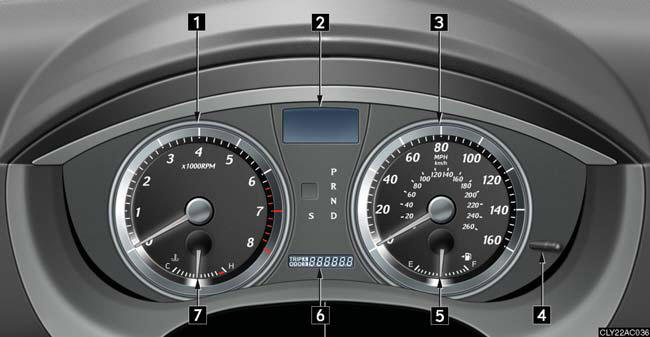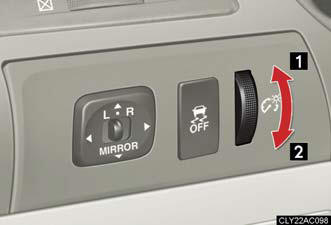Gauges and meters

The units used on the speedometer and the tachometer gauge display may differ depending on the model/type.
The following gauges, meters and display illuminate when the “ENGINE START STOP” switch is in IGNITION ON mode.
1. Tachometer.
Displays the engine speed in revolutions per minute.
2. Multi-information display.
3. Speedometer.
Displays the vehicle speed.
4. Odometer/trip meter and trip meter reset button.
Switches between odometer and trip meter displays. Pushing and holding the button will reset the trip meter when the trip meter is being displayed.
5. Fuel gauge.
Displays the quantity of fuel remaining in the tank.
6. Odometer and trip meter.
- Odometer.
Displays the total distance the vehicle has been driven.
- Trip meter.
Displays the distance the vehicle has been driven since the meter was last reset. Trip meters A and B can be used to record and display different distances independently.
7. Engine coolant temperature gauge.
Displays the engine coolant temperature.
Instrument panel light control
The brightness of the instrument panel lights can be adjusted.

1. Brighter.
2. Darker.
When the headlight switch is turned to ON, the brightness will be reduced slightly unless the control dial is turned fully up.
NOTICE:
To prevent damage to the engine and its components
- Do not let the indicator needle of the tachometer enter the red zone, which
indicates
the maximum engine speed.
- The engine may be overheating if the temperature gauge is in the red zone (H).
In
this case, immediately stop the vehicle in a safe place, and check the engine
after
it has cooled completely.
See also:
Used Lexus ES 350
Models Introduced for 2007, the present-generation Lexus ES 350 essentially
hasn't changed much, making low-mileage, well-kept examples top used car
choices.
The previous generation of the ES, w ...
Pricing Notes
The Manufacturer's Suggested Retail Prices (MSRP) on these mid-size sport
sedans reflect their impressive content and capabilities while keeping them
competitive and in line with offerings from th ...
Performance
Every good mark the RX line up earns in other areas is discredited by the
hybrid's performance attributes. To get such excellent mileage, the V-6 engine
is teamed with an electric motor and a larg ...
